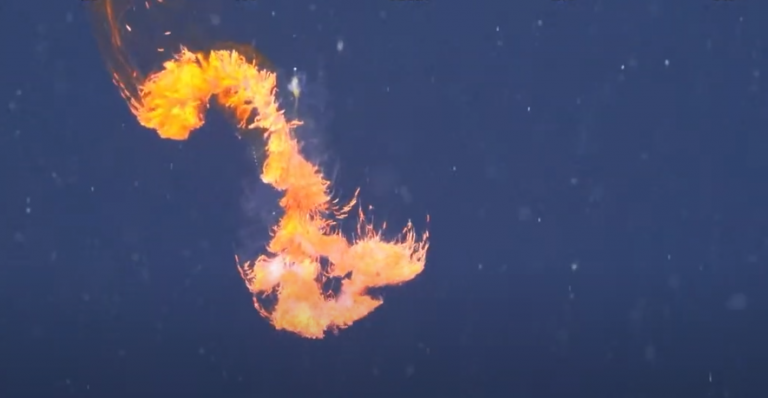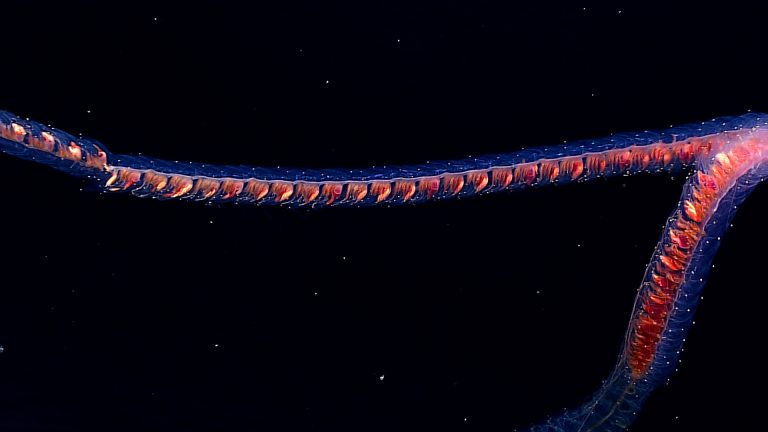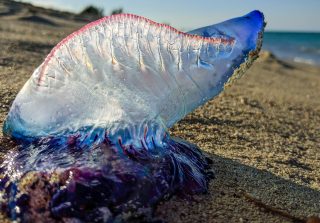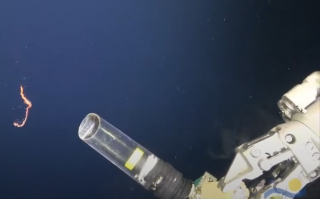During the first dive of the voyage, the Falkor Crew happened upon a bright, orange-red jelly seemingly feeding in a vast cloud of mucus. The Falkor team and viewers alike were awed by this “dragon-like” creature that looked as if it were on fire. We were lucky to have Dr. Dhugal Lindsay virtually along for the ride to explain that the fiery siphonophore was likely of the genus Marrus—possibly Marrus orthocanna – that has found its way south or Marrus antarcticus that has been swept north.

What exactly are siphonophores?
Siphonophores, like corals, anemones, and true jellies, are Cnidarians. They are carnivorous and colonial—mostly existing in the depths of the oceans. So far, scientists have described 175 species of siphonophores, but because the deep ocean is still largely unexplored, each new venture into the depths brings the possibility of new discoveries.
Many siphonophores are long and thin, with some species as long as 40 m—making these the longest animals in the world. They are usually translucent, but some deepwater species have characteristic orange or red digestive systems, and many species are bioluminescent when disturbed. The massive siphonophore seen on the #NingalooCanyons expedition may be the longest animal ever seen.

Most species are active swimmers, although there are some exceptions. Perhaps the most well-known siphonophore, the Portuguese man-o-war, lives on the surface of the ocean, with tentacles that can extend 30 m into the water column.

Siphonophores are exceptionally interesting, and we still have so much to learn about them. For example, colonialism in siphonophores is markedly different from other Cnidarians. Colonialism in Cnidarians tends to comprise many genetically identical multicellular individuals (zooids) that are physiologically integrated. However, in Siphonophores, each individual is specialized for a particular function, such as swimming or feeding. Further, the individuals are arranged in repetitive species-specific patterns along the stem.
This specialization is fascinating because it is similar to the evolution of specialized functions at other biological organization levels, for example, cells in multicellular organisms. Studying this aspect of siphonophore morphology may provide insight into the development of specialized systems in organisms and eventually lead to breakthroughs in medical research for conditions like cancer.
Siphonophores are gelatinous and fragile, so they are frequently damaged using standard sampling methods (mainly nets), disintegrating into nothing. Vessels like R/V Falkor equipped with ROVs like SuBastian are essential tools because they allow us to understand these animals better. Not only can we now observe these animals as they interact with the environment, but we can also collect pristine samples that will enable us to study their morphology better.

Dr. Lindsay mused that all the zooids on our fiery siphonophore were colored rather than just the stomach section. This species could also provide new information about geographic or temperature range expansions, which is especially relevant as the oceans continue to warm. We may not be sure what we have learned quite yet, but if anyone can figure it out for us, the Jellyman can.

